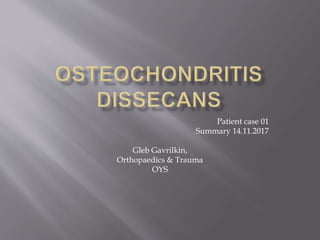Knee pain patient, procedures and results 01
- 1. Patient case 01 Summary 14.11.2017 Gleb Gavrilkin, Orthopaedics & Trauma OYS
- 2. ? Male, 24 years old ? Normal physiological alignment in leg ? Physiological femoral and tibial torsions ? Active sports activity ? BMI 22 ? Knee pain with physical activity ? Hydrops, swelling ? CRP, Leuk level normal
- 3. ? X-rays: ? Lateral femoral condyleĪ»s large osteochondral defect ? Sagital x-rays: anteriorly 1.5cm bone fragment ? Secundar OA in lateral femoral condyle, osteophytes ? OCD?
- 4. ? MRI: ? 2.3 x 1.6 mm OCD bone fragment anteriorly in Hoffa ? 2.4 x 2.2 OCD defect in lateral condyle ? ACL, PCL, MCL, LCL, menisci normal
- 5. ? MRI axial: ? 20 x 30 mm defect in lateral condyle
- 6. ? Lateral parapatellar arthrotomy ? Arthrex Mega-OATS instrumentation ? 20mm - bone allograft ? FOCA (fresh osteochondral allograft) technique ? Tapping fixation, no need for extra fixation devices
- 8. ? Active range of motion ? Full weight bearing ? Quadriceps rehab ? No sport activity at least 3 months ? Follow up with x-rays in 3 months ? Follow up with MRI in 6-12 month (to achive remodeling of the graft bone by the host bone)
- 9. ? Focal osteochondral defects of the knee in young, active patients can be a debilitating condition posing a complex treatment challenge. Due to their young age and high demands in their activity level, arthroplasty or arthrodesis surgery are not generally regarded reasonable solutions. ? For posttraumatic osteochondral defects, more biologic options to date have included realignment osteotomy, microfracturing, mosaicplasty, periosteal grafts, autologous chondrocyte transplantation, and osteochondral allograft transplantation. ? These procedures offer a biologic solution rather than an arti?cial bearing surface replacement with its inherent risks of early loosening and loss of bone stock for future surgeries.








